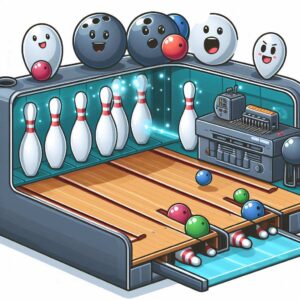In the world of bowling, having the right equipment can make all the difference in your game. Among the various types of bowling balls available, reactive balls have become increasingly popular due to their exceptional performance on modern lane conditions.
These balls are designed with a specialized reactive resin coverstock that interacts with the lane oil in a unique way, providing enhanced hook potential and backend reaction. Whether you’re a seasoned bowler or just starting out, understanding reactive bowling balls can help you elevate your skills and consistency on the lanes.
This comprehensive guide will delve into the intricacies of reactive bowling balls, covering everything from their construction and properties to selecting the right ball for your playing style and maintaining its performance over time. So, let’s explore the fascinating world of reactive bowling balls and unlock the secrets to achieving your best game.
Understanding Reactive Bowling Balls
To fully appreciate the benefits of reactive bowling balls, it’s essential to grasp the unique characteristics that set them apart from other ball types. At the heart of a reactive ball lies the reactive resin coverstock, a specialized material that interacts differently with lane oil compared to traditional coverstocks like urethane or particle.
Reactive Resin Coverstock:
The reactive resin coverstock is formulated with a distinct chemical composition that allows it to absorb and repel lane oil in a controlled manner.
When a reactive ball encounters oil on the lane, the coverstock creates a thin, temporary oil ring that helps the ball maintain its axis rotation and preserve its energy as it transitions from the oily to the dry portion of the lane.
This controlled absorption and repulsion of oil enable reactive balls to generate more backend hook and striking power, making them ideal for players seeking increased entry angle and pin-carrying potential.
Core Dynamics:
In addition to the coverstock, the core design of a reactive bowling ball plays a crucial role in influencing its motion and reaction on the lanes. Reactive balls are available with various core configurations, including symmetric and asymmetric designs.
Symmetric cores provide a more predictable and controlled ball motion, while asymmetric cores introduce additional flare potential and increased backend reaction. Manufacturers carefully engineer these core dynamics to complement the reactive coverstock and cater to different playing styles and lane conditions.
Particle/Solid Coverstock:
Within the realm of reactive bowling balls, there are two main categories: particle and solid coverstocks. Particle reactive balls feature a coverstock material infused with microscopic particles, often ceramic or glass, which enhance traction and create a distinct sense of “grabbing” on the backend. Solid reactive balls, on the other hand, have a smooth, particle-free coverstock that offers a more controlled and predictable reaction, making them ideal for players seeking a balanced blend of hook and control.
Choosing the Right Reactive Ball
With the vast array of reactive bowling ball options available, selecting the perfect ball for your game can be a daunting task. However, by considering a few key factors, you can narrow down your choices and find the reactive ball that best suits your playing style and lane conditions.
Playing Style:
Your playing style is one of the most significant determinants when choosing a reactive ball. Factors like rev rate (the amount of revolutions you impart on the ball), ball speed, axis tilt, and overall technique all play a role in how a particular reactive ball will perform for you. For instance, high rev-rate players may benefit from aggressive reactive balls with strong backend motion, while players with lower rev rates may prefer reactive balls with more controlled and predictable reactions.
Lane Conditions:
The lane conditions you typically encounter should also guide your reactive ball selection. For dryer, more challenging patterns often found in competitive tournaments or sport shots, you’ll want a reactive ball with a strong coverstock that can create ample traction and backend hook. Conversely, on more forgiving house shots with heavier oil volumes, a reactive ball with a slightly smoother or polished coverstock may provide better control and prevent over-reaction.
Ball Motion Preferences:
Individual preferences for ball motion characteristics like length, backend reaction, and overall shape also factor into your reactive ball choice. Some bowlers prefer an earlier and more aggressive backend hook, while others favor a more gradual and controlled arc. Matching your desired ball motion to the reactive ball’s specifications can enhance your comfort level and consistency on the lanes.
Popular Reactive Ball Lines and Models
With so many reactive bowling ball options available from various manufacturers, it can be overwhelming to navigate the market. To help you get started, let’s explore some of the most popular and highly regarded reactive ball lines and models from leading brands.
Storm: As one of the pioneers in reactive ball technology, Storm has consistently produced top-performing reactive balls for bowlers of all levels. The Hy-Road line, which includes balls like the Hy-Road Pearl and Hy-Road Nano, is renowned for its exceptional backend motion and pin-carrying ability. The Physix line, featuring balls like the Physix and Physix Guardians, offers a balanced blend of control and hook potential, making it a versatile choice for various lane conditions.
Rotogrip: Rotogrip, a subsidiary of Storm, has also made a significant impact in the reactive ball market. The Hustane line, including the Hustane Pearl and Hustane Solid, is widely praised for its strong backend reaction and exceptional carry on heavy oil patterns. The Winner line, with models like the Winner Solid and Winner Pearl, provides a balanced combination of hook and control, suitable for a wide range of playing styles and lane conditions.
Motiv: Motiv has gained a loyal following among bowlers with its innovative and high-performance reactive balls. The Venom line, featuring the Venom Shock and Venom Cobra, is known for its aggressive backend motion and ability to handle even the most challenging lane conditions. The Jackal line, with balls like the Jackal Ghost and Jackal Carnage, offers a more controlled and predictable reaction, making it a great choice for bowlers seeking a balanced ball motion.
These are just a few examples of the many popular reactive ball lines and models available on the market. When selecting a reactive ball, it’s essential to research and seek advice from knowledgeable pro shop professionals or experienced bowlers to ensure you find the perfect match for your game.
Maintaining and Extending Reactive Ball Life
Investing in a high-quality reactive bowling ball is just the first step; proper maintenance is crucial to ensure your ball continues to perform at its best for years to come. By following a few simple practices, you can extend the life of your reactive ball and maintain its exceptional performance on the lanes.
Surface Adjustments: One of the advantages of reactive bowling balls is the ability to adjust their surface roughness or grit to enhance or control the ball’s reaction. Depending on the lane conditions and your preferences, you can use various abralon pads or sandpaper grits to increase or decrease the surface roughness. A rougher surface will create more friction and enhance backend hook, while a smoother surface will promote a more controlled and predictable reaction.
Cleaning and Polishing: Regular cleaning and polishing are essential for maintaining the integrity of your reactive ball’s coverstock. After each use, thoroughly clean the ball with a approved ball cleaner to remove any dirt, oil, or debris that may have accumulated during play. Following the cleaning process, use a dedicated ball polish or reviver to restore the coverstock’s original shine and performance characteristics.
Resurfacing and Repairing: Over time, even with proper care, your reactive ball’s coverstock may become dull or lose its original reaction due to wear and tear. In such cases, it’s recommended to have your ball professionally resurfaced or recoated by a qualified pro shop operator. This process involves carefully removing a thin layer of the coverstock and applying a fresh coat of reactive resin, effectively restoring the ball to its original condition. Additionally, minor cracks or gouges in the coverstock can often be repaired through specialized techniques, further extending the life of your reactive ball.
Conclusion:
Throughout this comprehensive guide, we’ve explored the fascinating world of reactive bowling balls, uncovering their unique properties, construction, and the factors that make them such a powerful tool for enhancing your bowling game.
From understanding the reactive resin coverstock and its interaction with lane oil to selecting the perfect ball for your playing style and lane conditions, this guide has provided you with the knowledge and insights needed to make informed decisions when investing in a reactive bowling ball.
We’ve delved into the intricacies of core dynamics, particle versus solid coverstocks, and the popular reactive ball lines and models from leading manufacturers. Additionally, we’ve covered essential maintenance practices, including surface adjustments, cleaning techniques, and resurfacing methods, to ensure your reactive ball continues to perform at its best for years to come.
By mastering the art of reactive bowling balls, you’ll unlock a world of enhanced hook potential, increased entry angles, and unmatched pin-carrying ability. Whether you’re a seasoned bowler seeking to take your game to new heights or a beginner looking to elevate your skills, reactive bowling balls can be the game-changing tool you need to consistently strike and dominate the lanes.
Remember, the journey to bowling excellence is an ongoing process, and reactive bowling balls are just one piece of the puzzle. Continually refine your technique, stay up-to-date with the latest bowling trends and technologies, and never stop learning and improving.
Embrace the power of reactive bowling balls, and experience the thrill of watching those pins explode with every shot. Happy bowling, and may your strikes be as explosive as the reaction of your reactive ball!





